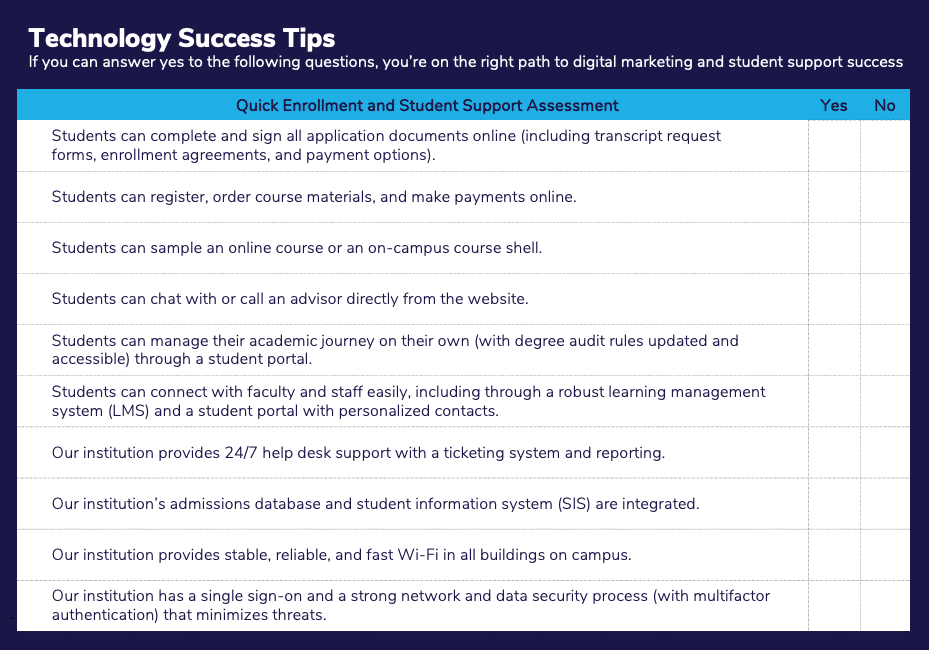The Digital University Ecosystem: Engaging and Supporting Students With Technology
The modern student makes meaningful contact with a prospective college or university before they ever set foot on its campus. That’s because they’re highly adept at seeking and gathering information from the institution’s website — which serves as the school’s virtual campus.
While curb appeal may still have its benefits, in today’s world, an engaging university website can have more influence on prospective students than any tree-lined quad or limestone-columned building. Students use websites to answer questions such as:
- Is this school right for them? What are the available programs, admissions criteria, paths to graduation, and costs?
- Can they find the information they need on their own, and can they do so quickly?
- Does this school provide the technology infrastructure and support resources that will allow them to be successful?
Both consciously and subconsciously, prospective students visit your website to assess whether they should continue exploring or hit the back arrow and continue scrolling. The world is at their fingertips — and they don’t need a tour guide to answer their questions.
This means having a website that is both attractive and informative is paramount for your institution. As the saying goes: You only get one chance to make a first impression. And for a technology-challenged school, that first impression often can fall flat.
Helping Students Find Your Logo
Google Maps and GPS technology help people get from one physical location to another. In the digital world, search engine optimization (SEO) plays a similar role.
SEO is crucial to helping students find their way from their home screen to your website. If done correctly, SEO can:
- Increase traffic from likely-to-convert audiences
- Build authority through content that drives real results
- Reduce the aggregate cost per enrollment over time
An effective SEO strategy can have a much bigger impact and produce a better return on investment than any other marketing strategy. A truly robust SEO plan involves auditing current web pages, building a strategy to generate high-quality traffic, mapping the site for optimization and growth potential, and creating data-based reports that inform ongoing strategy.
Tools like Moz, SpyFu, and SEMrush can help institutions conduct keyword research and handle SEO campaign management. These platforms can be a great starting point for a technology-challenged school, allowing it to see where its website stands and how it can improve.
Encouraging Students to Open the Front Door
SEO plays a pivotal role in transforming a technology-challenged institution. But SEO is only the beginning. When students click on your website after a search, they’re knocking at your front door. You need to be ready to greet them with a sleek and streamlined website that addresses their most pressing inquiries about the enrollment process. Here are some tips to optimize the student experience:
- Keep It Simple. Your institution has a lot to offer. But bombarding prospective students with too much information, especially as they form their first impression, can overwhelm them and drive them away from your website.
- Encourage Exploration. Concise messaging that leads to key pages invites students to dig deeper. Students should be able to easily navigate to more detailed information on program requirements, costs, and admissions processes.
- Use Engaging Language. Minimize “Request Information” and “Inquire Here” links on every page — instead consider calls to actions such as “Explore Further” using personalized digital student experiences like Archer Education’s Onward engagement platform.
- Embed Media and Images. Today’s students are skimming. Digestible visual media such as videos and images can help them get acquainted with your institution’s culture without having to read dense chunks of text.
Throughout your website, provide students with a clear path about how to become a student. Answer critical questions such as:
- When do classes start?
- When are the application and enrollment deadlines?
- What needs to be completed for admission?
- What are the tuition rates? Are there fees?
- What are the funding/scholarship options?
- What careers can students pursue after completing the program?
- Who are the faculty members?
- What will students learn in the program?
When you answer these questions directly and concisely, students get the information they need and begin to trust your institution. Now it’s time to invite them into the house.
Welcoming Students into the Living Room
After being warmly greeted at your front door, students will be ready to request information and ask for support. This critical juncture shouldn’t be met with a static response like: “Thank you for your interest. Someone will be in touch.”
Instead, invite them inside. Show them around a little bit. Make them feel comfortable and confident in their decision to keep exploring. A great way to do this is with a responsive, user-driven digital student experience (such as Onward) that encourages them to think about important elements of their education, such as:
- What are they looking to accomplish with their degree?
- What are they looking for in an institution?
- How are they planning to finance their education?
- When do they want to finish their degree?
- Do they have any transfer credits?
- What student support resources are available?
- What technology tools are available?
- What are the graduation rates?
When prospective students start to think about these things at the moment of inquiry, they’re more likely to see themselves at your school and to understand what an education could mean for their future. Providing an experience like this is the difference between a technology-challenged school and a school that leverages technology to increase enrollment.

Empowering Students to Explore the Great Outdoors
After students get their fill of sipping lemonade and lounging on the couch, encourage them to check out the neighborhood. Extracurricular activities matter, even to adult learners. All students want to feel a sense of community and belonging.
This means that your follow-up messages, including your omnichannel email and text message nurturing, social media efforts, and advisor outreach should demonstrate all the great things going on at your school. Help students envision their lives as part of your campus community — whether that’s online or in person.
Discarding Your Identity as a Technology-Challenged School
Archer Education partners with all kinds of institutions to help them transition from technology-challenged schools to those that gain a competitive edge with technology. Contact our team to learn more about how we can transform your institution’s student journey through tech-enabled marketing, enrollment, and retention services.



